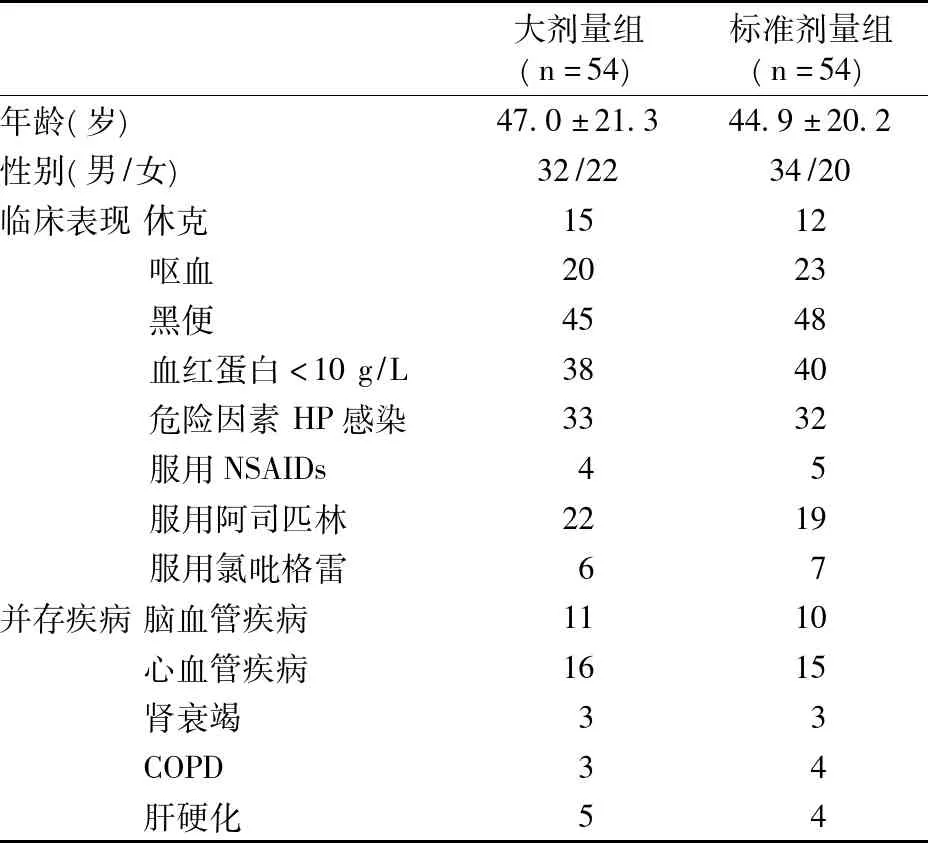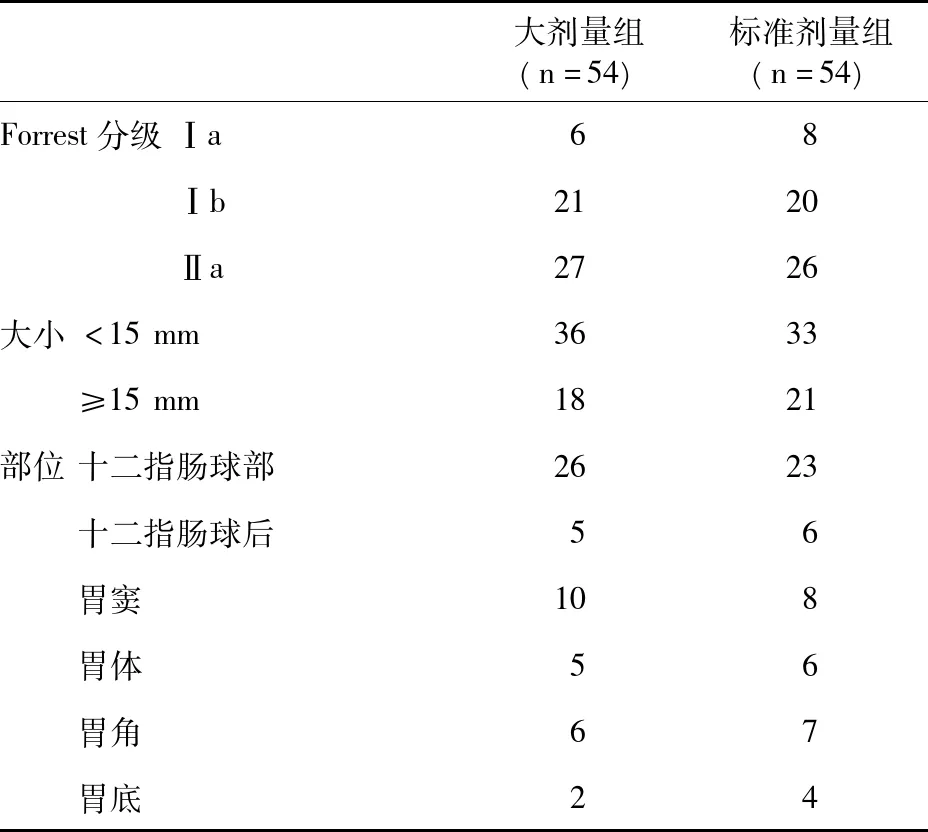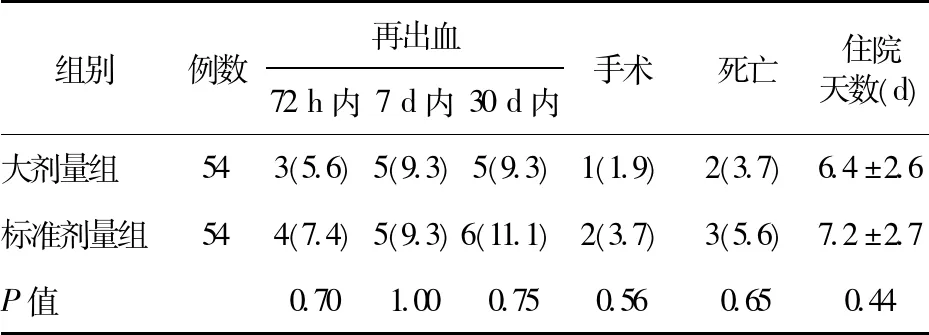不同剂量埃索美拉唑预防消化性溃疡并出血内镜止血后再出血的临床观察
2015-02-16丁世华郭海建吴东海
丁世华,郭海建,吴东海,曾 理,刘 俊
·短篇论著·
不同剂量埃索美拉唑预防消化性溃疡并出血内镜止血后再出血的临床观察
丁世华,郭海建,吴东海,曾 理,刘 俊*
目的 比较不同剂量埃索美拉唑预防消化性溃疡并出血内镜止血后再出血的效果。方法108例消化性溃疡并出血患者经肾上腺素粘膜下注射联合电凝或止血夹治疗成功止血后,随机分成2组。大剂量组给予埃索美拉唑80 mg静推+8 mg/h输注,维持72 h;标准剂量组给予埃索美拉唑80 mg静推+40 mg静推,q12 h,维持72 h。两组患者随后均给予埃索美拉唑20 mg,1次/d,维持治疗27 d。结果大剂量组72 h、7 d、30 d再出血率分别为5.6%、9.3%、9.3%,与标准剂量组(7.4%、9.3%、11.1%)比较差异无统计学意义(P>0.05)。两组患者住院时间、外科手术率、死亡率比较差异无统计学意义(P>0.05)。结论不同剂量埃索美拉唑预防高危消化性溃疡并出血内镜止血后再出血的效果相当。
消化性溃疡;出血;埃索美拉唑;预防
0 引言
内镜下止血是治疗消化性溃疡并出血(Peptic ulcer bleeding,PUB)的首选方法[1],但是内镜下成功止血后,仍有20%左右的再出血率。既往的研究显示,质子泵抑制剂(Proton pump inhibitor,PPI)可以减少内镜止血治疗后的再出血,但是关于给药方式及最佳剂量存在争议[2-5]。因此,笔者观察了不同剂量埃索美拉唑治疗高危消化性溃疡并出血的临床疗效,现报道如下。
1 资料和方法
1.1 一般资料 2010年5月至2013年5月在我院消化内科住院的消化性溃疡并出血的患者108例,符合纳入标准并有完整的临床资料,其中大剂量组54例,标准剂量组54例,两组患者基本特征及内镜表现差异无统计学意义,见表1和表2。

表1 两组患者基本临床特征比较

表2 两组患者内镜下表现比较
1.2 纳入和排除标准 临床表现呕血和(或)黑便、便血,经胃镜诊断为胃或十二指肠溃疡,内镜Forrest分级为喷血Ⅰa、渗血Ⅰb、裸露血管Ⅱa,凝血块Ⅱb冲洗后,表现为Ⅰa、Ⅰb、Ⅱa,并经内镜下止血成功者纳入。孕妇、儿童、急性心肌梗死、脑血管意外急性期、恶性溃疡、有出血倾向(血小板<50×109/L、国际化比值>1.5)者排除。
1.3 治疗方法及分组 内镜Forrest分级为Ⅰa、Ⅰb、Ⅱa给予1∶10 000肾上腺素粘膜下注射联合电凝或止血夹治疗,内镜下成功止血后随机分成2组。大剂量组接受埃索美拉唑 80 mg静推+8 mg/h输注,维持72 h;标准剂量组接受埃索美拉唑80 mg静推+40 mg静推,q12h,维持72 h。两组患者随后均给予埃索美拉唑20 mg,1次/d,维持治疗27 d。同时均给予禁食、补液、输血等常规治疗。
1.4 观察指标 72 h、7 d、30 d时的再出血率,住院时间,外科手术率,死亡率。

2 结果
大剂量组72 h、7 d、30 d再出血率分别为5.6%、9.3%、9.3%,与标准剂量组(7.4%、9.3%、11.1%)比较差异无统计学意义(P>0.05)。Kaplan-Meier法分析30 d内再出血率差异无统计学意义(Log-rank test,P=0.75)。大剂量组有1例转外科手术(1.9%),标准剂量组2例转外科手术(3.7%),两组手术率比较差异无统计学意义(P=0.56)。大剂量组死亡2例(3.7%),标准剂量组死亡3例(5.6%),两组死亡率比较差异无统计学意义(P=0.65)。大剂量组住院天数(6.4±2.6)d,标准剂量组住院天数(7.2±2.7)d,两组比较差异无统计学意义(P=0.44)。见表3。

表3 两组患者治疗后结果比较(例,%)
3 讨论
PPI能够特异性和非竞争性抑制H+-K+-ATP酶,有强大的抑制胃酸分泌作用,能够迅速提高胃内pH值;胃内pH值>6时有利于血小板聚集,启动凝血机制,同时可减少血凝块溶解,从而达到止血的目的。几项PPI和安慰剂或不治疗比较的临床对照研究显示,PUB内镜止血治疗后,给予PPI治疗能够迅速提高胃内pH值并且维持pH>6的水平,从而减少再出血率、外科手术率,缩短住院时间[6-8]。因此,非静脉曲张性上消化道出血国际共识和中国共识均推荐内镜下成功止血后予大剂量PPI治疗(80 mg静推+8 mg/h输注维持72 h)[9-10]。但对这两项国际和国内共识意见推荐的PPI剂量很多地区和学者有不同的意见。印度学者Javid等[11]分别检测PUB内镜下止血后予奥美拉唑、泮托拉唑、雷贝拉唑80 mg静推+8 mg/h输注维持72 h和口服奥美拉唑、泮托拉唑、雷贝拉唑80 mg+40 mg q12h维持72 h的胃内pH值,结果显示,不同种PPI和不同剂量的给药方式72 h胃内pH均值差异无统计学意义。香港Hung等[12]的随机对照试验显示,PUB内镜止血后分别予泮托拉唑80 mg静推+8 mg/h输注维持72 h和泮托拉唑80 mg静推+40 mg静推(q12h),维持72 h;72 h内胃内pH均值和pH>6的时间比较差异无统计学意义,两组患者的再出血率、外科手术率和死亡率差异也无统计学意义。台湾Chen等[13]报道,PUB内镜止血后分别予泮托拉唑80 mg静推+8 mg/h输注维持72 h和泮托拉唑40 mg静推(qd)维持72 h;两组患者72 h、7 d和30 d内再出血率分别是4.1%、6.2%、6.2% vs.4.2%、4.2%、5.2%,差异无统计学意义;两组患者的再出血率、外科手术率和死亡率比较差异也无统计学意义,因此,认为两种剂量临床效果相当。而国内西京医院的一项随机对照研究显示,强化大剂量PPI治疗PUB再出血率为6.4%,明显低于标准PPI治疗组(11.0%,P=0.02),而两组患者的手术率和死亡率比较差异无统计学意义[14]。
笔者在临床实践中观察到,PUB内镜下止血后间断给予PPI治疗也有很好的效果。既往研究表明,低危险PUB患者(内镜Forrest分级Ⅱc、Ⅲ)很少再出血,为了减少低危险患者影响治疗效果的观察,我们选择了高危患者(内镜Forrest分级Ⅰa、Ⅰb、Ⅱa)为研究对象。同时,为了减少内镜治疗技术对再出血的影响,我们采用标准的内镜止血方法即肾上腺素粘膜下注射联合电凝或止血夹治疗,而非单一的肾上腺素粘膜下注射止血术。最后有108例患者纳入了研究,每组54例,两组患者的基本临床特征和内镜下表现基本相似。经过30 d的随访,结果显示,大剂量组72 h、7 d、30 d再出血率与标准剂量组比较差异无统计学意义(P>0.05)。Kaplan-Meier法分析30 d内再出血率差异无统计学意义(P=0.75),两组患者死亡率、手术率、住院天数比较差异无统计学意义(P>0.05),两组不同剂量PPI治疗临床效果相当。从节省医疗成本和减少药物不良反应的角度,PUB内镜成功止血后,予较小剂量的PPI治疗可以达到同样的临床效果。本研究的不足之处:没有采用盲法,没有检测胃内pH值。本次研究的结论还需要更多的多中心、随机、双盲对照试验进一步验证。
[1] Kim KB,Yoon SM,Youn SJ.Endoscopy for nonvariceal upper gastrointestinal bleeding[J].Clin Endosc,2014,47(4):315-319.
[2] Songür Y,Balkarli A,Acartürk G,et al.Comparison of infusion or low-dose proton pump inhibitor treatments in upper gastrointestinal system bleeding[J].Eur J Intern Med,2011,22(2):200-204.
[3] Yen HH,Yang CW,Su WW,et al.Oral versus intravenous proton pump inhibitors in preventing re-bleeding for patients with peptic ulcer bleeding after successful endoscopic therapy[J].BMC Gastroenterol,2012,12:66.
[4] Sung JJ,Barkun A,Kuipers EJ,Intravenous esomeprazole for prevention of recurrent peptic ulcer bleeding: a randomized trial[J].Ann Intern Med,2009,150(7):455-464.
[5] Masjedizadeh AR,Hajiani E,Alavinejad P,et al.High dose versus low dose intravenous pantoprazole in bleeding peptic ulcer: a randomized clinical trial[J].Middle East J Dig Dis,2014,6(3):137-143.
[6] Zargar SA,Javid G,Khan BA,et al.Pantoprazole infusion as adjuvant therapy to endoscopic treatment in patients with peptic ulcer bleeding: prospective randomized controlled trial[J].J Gastroenterol Hepatol,2006,21(4):716-721.
[7] Lau JY,Sung JJ,Lee KK,et al.Effect of intravenous omeprazole on recurrent bleeding after endoscopic treatment of bleeding peptic ulcers[J].N Engl J Med,2000,343(5):310-316.
[8] Simon-Rudler M,Massard J,Bernard-Chabert B,et al.Continuous infusion of high-dose omeprazole is more effective than standard-dose omeprazole in patients with high-risk peptic ulcer bleeding: a retrospective study[J].Aliment Pharmacol Ther,2007,25(8):949-954.
[9] 《中华内科杂志》编委会,《中华消化杂志》编委会,《中华消化内镜杂志》编委会.急性非静脉曲张性上消化道出血诊治指南(2009.杭州)[J].中华消化杂志,2009,29(10):682-685.
[10]Barkun AN,Bardou M,Kuipers EJ,et al.International consensus recommendations on the management of patients with nonvariceal upper gastrointestinal bleeding[J].Ann Intern Med,2010,152(2):101-113.
[11] Javid G,Zargar SA,U-Saif R,et al.Comparison of p.o.or i.v.proton pump inhibitors on 72-h intragastric pH in bleeding peptic ulcer[J].J Gastroenterol Hepatol,2009,24(7):1236-1243.
[12] Hung WK,Li VK,Chung CK,et al.Randomized trial comparing pantoprazole infusion,bolus and no treatment on gastric pH and recurrent bleeding in peptic ulcers[J].ANZ J Surg,2007,77(8):677-681.
[13] Chen CC,Lee JY,Fang YJ,et al.Randomised clinical trial: high-dose vs.standard-dose proton pump inhibitors for the prevention of recurrent haemorrhage after combined endoscopic haemostasis of bleeding peptic ulcers[J].Aliment Pharmacol Ther,2012,35(8):894-903.
[14] Liu N,Liu L,Zhang H,et al.Effect of intravenous proton pump inhibitor regimens and timing of endoscopy on clinical outcomes of peptic ulcer bleeding[J].J Gastroenterol Hepatol,2012,27(9):1473-1479.
Observation of different doses of esomeprazole for the prevention of recurrent haemorrhage after endoscopic haemostasis of bleeding peptic ulcers
DING Shi-hua,GUO Hai-jian,WU Dong-hai,ZENG Li,LIU Jun*
(Department of Gastroenterology,The Second People′s Hospital of Shenzhen,Shenzhen 518035,China)
Objective To compare the preventive effect of different doses of esomeprazole on hemorrhage after endoscopic haemostasis.MethodsA total of 108 patients with bleeding ulcers undergoing endoscopic treatment with epinephrine injection and heater probe thermocoagulation or clip were randomized to receive a high-dose regimen (80 mg bolus,followed by esomeprazole 8 mg/h infusion,n=54) or a standard-dose regimen (esomeprazole 40 mg bolus q12h,n=54).After 72 h,all patients were given 20 mg esomeprazole daily orally for 27 d.ResultsThe rates of recurrent bleeding in 72 h,7 d and 30 d separately were 5.6%,9.3%,9.3% in high dose group,and 7.4%,9.3%,11.1% in standard dose group(P>0.05).There was no significant difference in hospital stay time,the rate of surgical interventions and mortality between the two groups.ConclusionDifferent doses of esomeprazole show similar effect on the prevention of recurrent haemorrhage after endoscopic haemostasis in high-risk bleeding peptic ulcers.
Peptic ulcer;Bleeding;Esomeprazole;Prevention
2014-10-15
深圳市第二人民医院消化内科,深圳 518035
*通信作者
10.14053/j.cnki.ppcr.201505030
